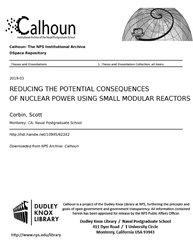File:REDUCING THE POTENTIAL CONSEQUENCES OF NUCLEAR POWER USING SMALL MODULAR REACTORS (IA reducingthepoten1094562242).pdf

Original file (1,275 × 1,650 pixels, file size: 2.26 MB, MIME type: application/pdf, 108 pages)
Captions
Captions
Summary[edit]
| REDUCING THE POTENTIAL CONSEQUENCES OF NUCLEAR POWER USING SMALL MODULAR REACTORS
( |
||
|---|---|---|
| Author |
Corbin, Scott |
|
| Title |
REDUCING THE POTENTIAL CONSEQUENCES OF NUCLEAR POWER USING SMALL MODULAR REACTORS |
|
| Publisher |
Monterey, CA; Naval Postgraduate School |
|
| Description |
In order for commercial nuclear power to remain successful in the United States, several things need to occur: advancement of newer technologies and replacement of aging infrastructure with a new generation of safe reactors that are reliable, adaptable to the environment, cost-effective, and energy efficient to meet the nation’s energy demands into the future. To accomplish this, the United States must be able to identify true risk rather than the perceived risk of civilian nuclear power and have solutions to manage it. Risk management includes reducing the U.S. carbon footprint, which is contributing to global warming. The nation also must find a way to close the loop on nuclear waste through reprocessing and recycling. Furthermore, by reducing their size as compared to existing commercial power plant operations, the United States can locate new plants where energy is most needed. Finally, this thesis demonstrates how the potential consequences of a nuclear plant accident can be reduced to acceptable levels through the use of small modular reactors. Subjects: nuclear power; SMR; small modular reactor; risk perception; aging infrastructure; nuclear waste; emergency planning zone; core damage frequency; early cancer fatality rate; NuScale; latent cancer fatality rate; light water reactor; LWR; probability risk assessment; PRA; nuclear power plant; NPP; design-based accident; Clinch River |
|
| Language | English | |
| Publication date | March 2019 | |
| Current location |
IA Collections: navalpostgraduateschoollibrary; fedlink |
|
| Accession number |
reducingthepoten1094562242 |
|
| Source | ||
| Permission (Reusing this file) |
Copyright is reserved by the copyright owner. | |
Licensing[edit]
| Public domainPublic domainfalsefalse |
This work is in the public domain in the United States because it is a work prepared by an officer or employee of the United States Government as part of that person’s official duties under the terms of Title 17, Chapter 1, Section 105 of the US Code.
Note: This only applies to original works of the Federal Government and not to the work of any individual U.S. state, territory, commonwealth, county, municipality, or any other subdivision. This template also does not apply to postage stamp designs published by the United States Postal Service since 1978. (See § 313.6(C)(1) of Compendium of U.S. Copyright Office Practices). It also does not apply to certain US coins; see The US Mint Terms of Use.
|
 | |
| This file has been identified as being free of known restrictions under copyright law, including all related and neighboring rights. | ||
https://creativecommons.org/publicdomain/mark/1.0/PDMCreative Commons Public Domain Mark 1.0falsefalse
File history
Click on a date/time to view the file as it appeared at that time.
| Date/Time | Thumbnail | Dimensions | User | Comment | |
|---|---|---|---|---|---|
| current | 06:41, 24 July 2020 |  | 1,275 × 1,650, 108 pages (2.26 MB) | Fæ (talk | contribs) | FEDLINK - United States Federal Collection reducingthepoten1094562242 (User talk:Fæ/IA books#Fork8) (batch 1993-2020 #26263) |
You cannot overwrite this file.
File usage on Commons
The following page uses this file:
Metadata
This file contains additional information such as Exif metadata which may have been added by the digital camera, scanner, or software program used to create or digitize it. If the file has been modified from its original state, some details such as the timestamp may not fully reflect those of the original file. The timestamp is only as accurate as the clock in the camera, and it may be completely wrong.
| Short title | REDUCING THE POTENTIAL CONSEQUENCES OF NUCLEAR POWER USING SMALL MODULAR REACTORS |
|---|---|
| Image title | |
| Author | Corbin, Scott |
| Software used | Corbin, Scott |
| Conversion program | Adobe PDF Library 11.0 |
| Encrypted | no |
| Page size |
|
| Version of PDF format | 1.4 |

